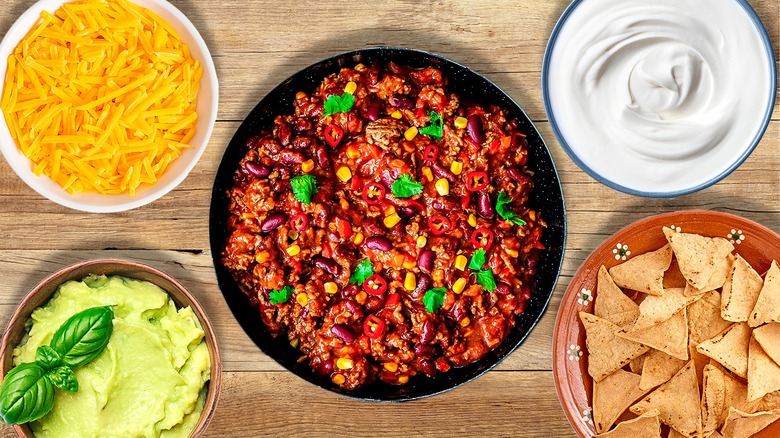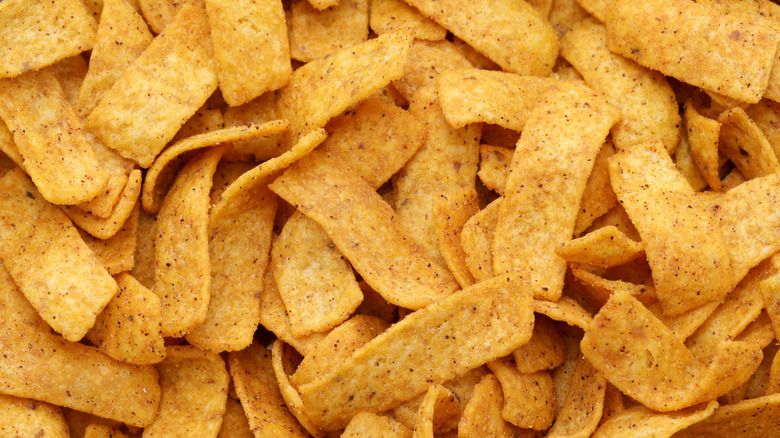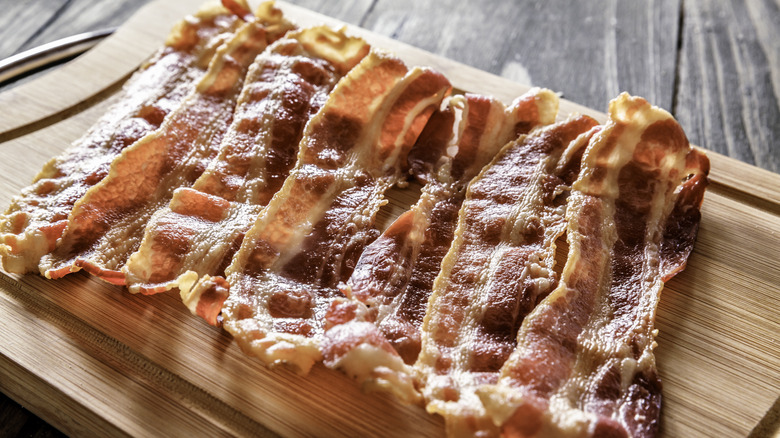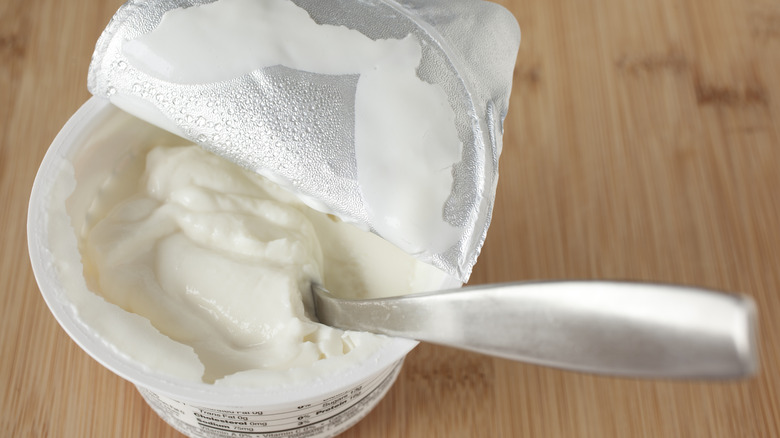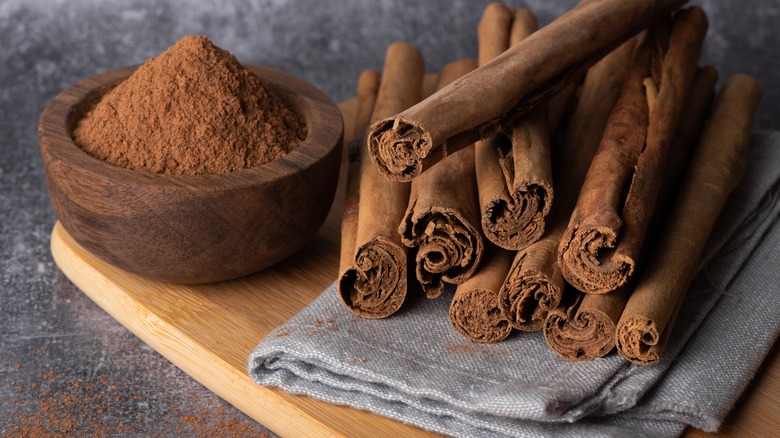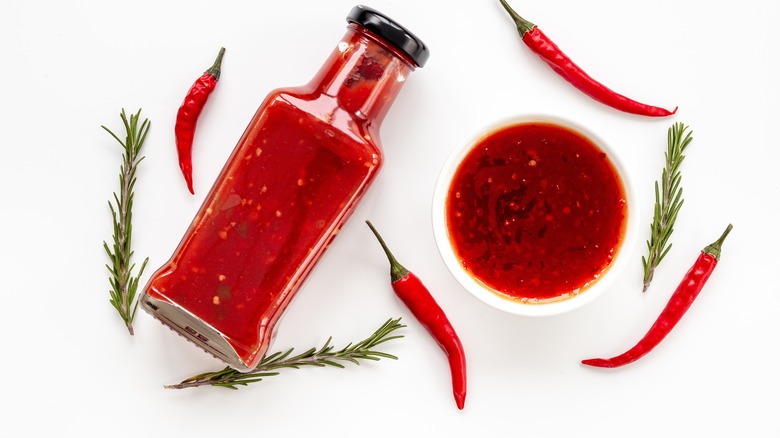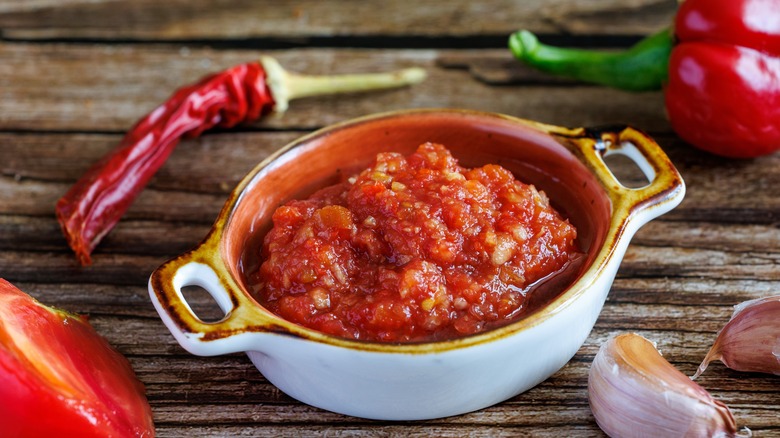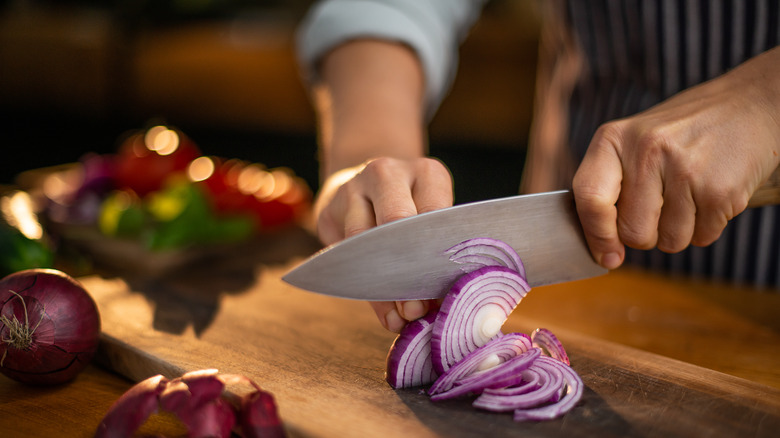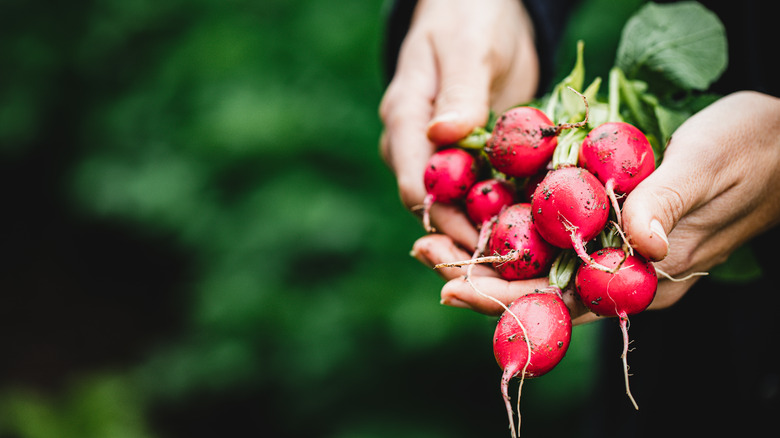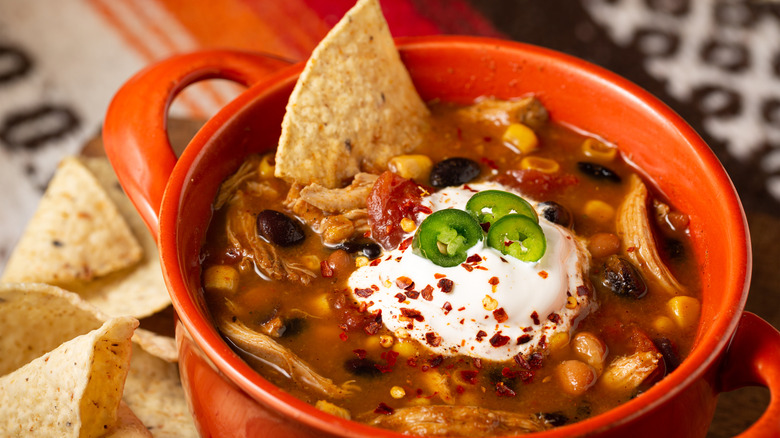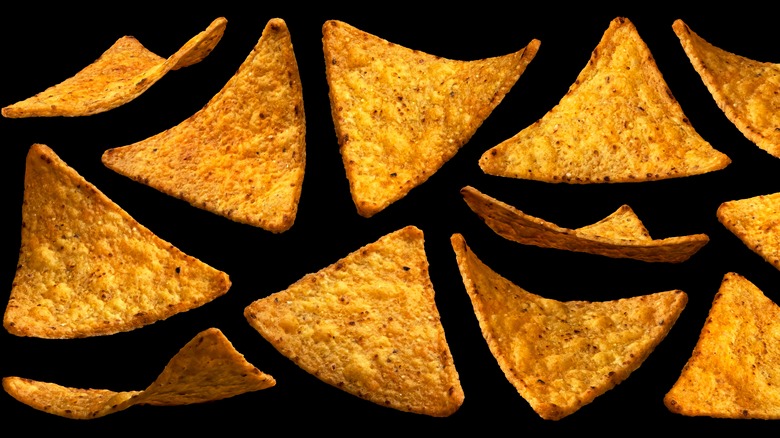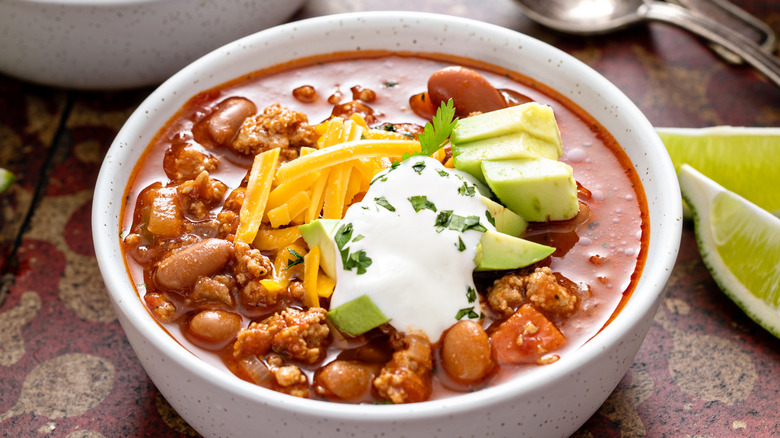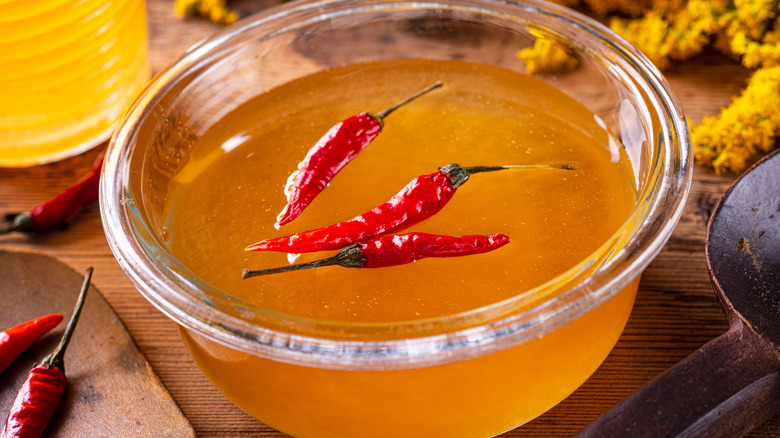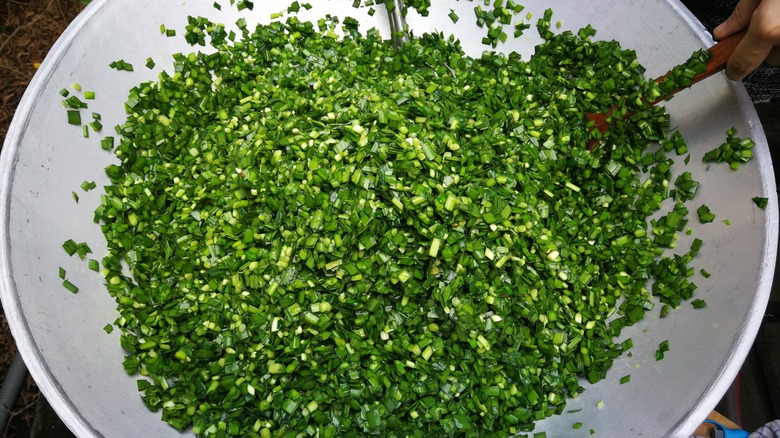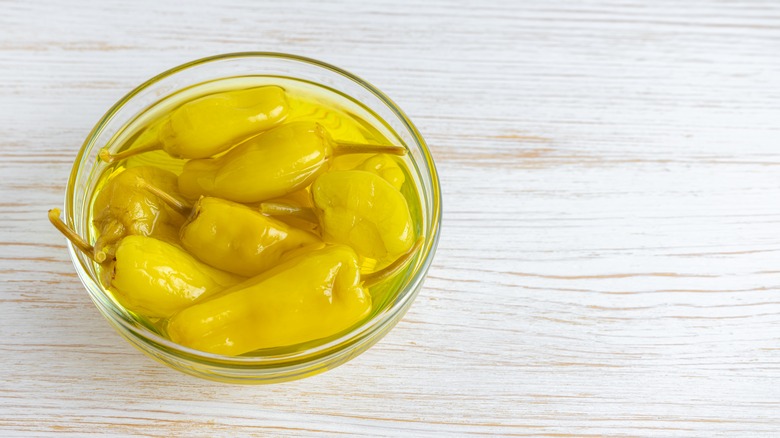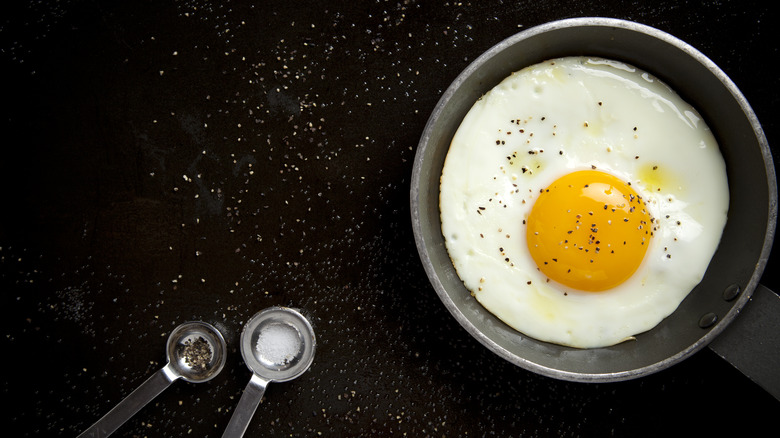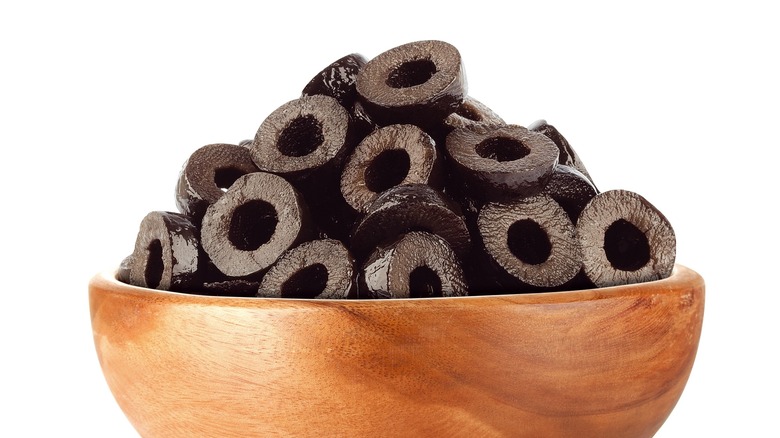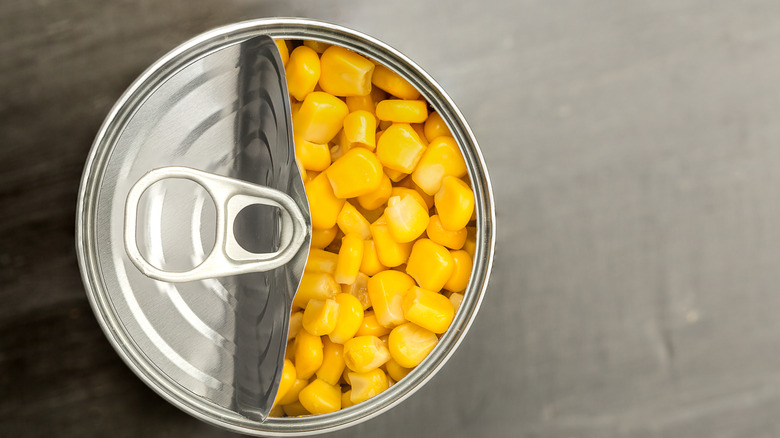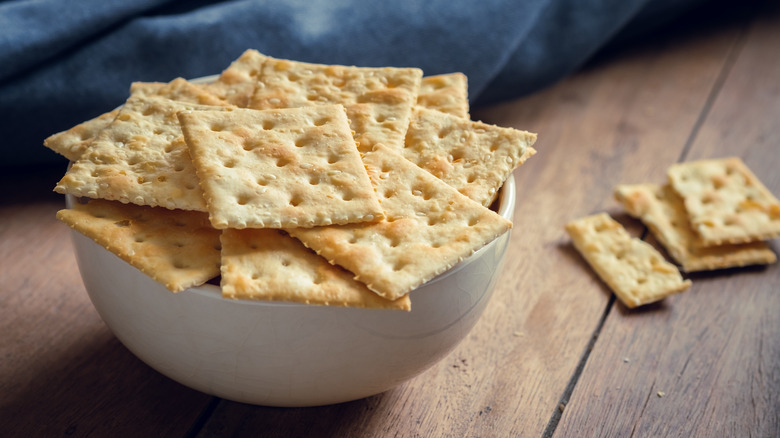20 Best Toppings For Better Chili
There's no better way to fill your belly on a blustery winter day than with a warm, fragrant bowl of chili. This hearty dish is incredibly versatile because you can swap in your favorite types of beans (or no beans, if you want to go rogue) or ground meat (or, of course, no meat). You can also choose a style with or without tomatoes. Add in your favorite array of spices and simmer it on low and you'll have yourself a hearty bowl of chili ready to eat in no time.
But before diving in, you must decide what ingredients to add to the top of your chili. The toppings you use can vary as much as the chili recipe itself. Some folks stick to the classic sour cream, cheese, and chives combo, while other folks gravitate to the spicy or sweet end of things. You can even create a fun interplay of textures to complement the richness of your recipe and take it to a new level. Here are some of the most popular (and delicious) chili toppings you can try for your next batch.
Corn chips
Corn chips are an excellent topping for people who like all things crunchy on their chili. The biggest difference between corn chips and tortilla chips is that the former are heartier and have a more pronounced corn flavor. When you dip your tortilla chips into your chili, they may disintegrate or crumble under the weight of the beans and the meat. From a structural perspective, corn chips are a better bet.
These chips come in many different shapes, so you can opt for a more scoop-like shape if you like using chips as utensils. You can also buy corn chips in different flavors, like barbecue or hot and spicy. We recommend trying the Trader Joe's Elote Corn Chip Dippers on your next chili; the subtle buttermilk tang contrasts well with a rich base.
This crunchy snack can also add texture to chili-topped foods, including chili dogs and chili-topped burgers. You'll love how the salty and umami flavors of the chip contrast the smokiness of a good chili.
Crumbled bacon
Crumbled bacon is the savory ingredient your chili needs. This staple breakfast food is a source of all things umami, and you can also buy smoked bacon if you want to amplify your chili's hickory notes. But, rather than just adding the bacon and its grease to the chili itself, you should also crisp some up and reserve it as a topping.
The key to serving bacon at your next chili bar is to ensure it's perfectly crispy rather than limp and soft. This will give you the optimal textural contrast between the toppings and the soft beans and meat. Be sure to reserve your leftover bacon grease to cook the onions and garlic. This fat will impart savory notes throughout your dish.
Cheddar cheese
Cheddar cheese has to be one of the all-time best toppings for chili. It's strange to see a bowl without a distinguishable gooey orange coating on top.
You don't have to stick with just the plain yellow cheddar for your chili recipe. Play with different sharpnesses to find one that works well for your palate. Or find a cheese studded with different flavors to amplify your chili. If you like all things spicy, a jalapeño cheddar might be your best bet. For a drier flavor, try Trader Joe's Unexpected Cheddar cheese — which tastes like the halfway point between sharp cheddar and Parmesan.
You can also try other cheeses besides cheddar. Cojita cheese has a more rubbery, tangy bite that complements Tex-Mex seasonings and toppings like chili powder and avocados. You can also use shredded American cheese if you're after a good melt.
Greek yogurt
Sour cream is undoubtedly the cream of the crop when it comes to rich chili toppings. But there's an underdog who's after the title: Greek yogurt. It has a sour flavor because it contains a lot of lactic acid bacteria. It's also much thicker than regular yogurt because it's strained to remove the liquid whey. So, don't crack open a container of strawberry Yoplait and think it will taste the same on top of your steaming bowl of chili.
Despite its thick texture, Greek yogurt isn't overtly heavy on the palate. So you can grab a scoop, swirl it into your bowl, and dig in. It pairs well with other additions like chives and will help distract your tastebuds from the spicy and smoky notes of the chili.
Cinnamon
You might wonder what a spice used for snickerdoodles and cinnamon rolls is doing in a steaming bowl of tomato, beans, and ground meat. But cinnamon is one of the best secret ingredients for making a great bowl of chili. This spice balances the acidic and spicy flavors of your chili and brings warmth to your bowl without cranking up the heat.
Besides adding cinnamon to the base of your chili, you should also add it as a garnish to the top of your bowl. Although some people enjoy adding chili powder instead, the cinnamon will give you a warm, inviting hint of flavor that will change the entire profile of your bowl. If you have watched enough cinnamon challenge videos on the interwebs, though, you know it would be wise to give your chili a good stir before you take a big bite.
Hot sauce
If you like a piquant flavor and a stinging mouthfeel from your chili, then grabbing a bottle of hot sauce is surely the way to go. There are so many different types of hot sauce out there that you can mix and match based on the flavor you're looking for. A Tabasco, for example, has a vinegary flavor, while a sriracha is much more garlic and chili-forward.
But our favorite hot sauce to put on chili is undoubtedly Cholulua. It's not tongue-tinglingly hot, but it does have a smoky undertone that complements ancho chili powder, tomato, and a variety of ground meats quite well. You can also add more on since it doesn't have the stinging flavor of other hot sauce varieties. Granted, if you're a hot sauce newbie or sensitive to spice, always add this condiment gradually and taste as you go.
Salsa
It might seem a bit strange to put salsa on top of a dish that already has enough tomatoes and onions inside of it. But when you think about it, salsa is just a fresher interpretation of your chili ingredients. Plus, it has a distinct hint of acid and brightness that will help distract from the heaviness of your beans, ground meat, and other toppings.
The exact kind of salsa you use for your chili topping really depends on what else is in your chili. If you're making a tomatillo chili, you should try to serve it with a tomatillo salsa. Or, if you're working with a hearty turkey chili recipe, pair it with a bright and chunky pico de gallo to help mellow out its richness.
Raw onions
We're not going to beat around the bush here: Onions are a pungent condiment that not everyone will enjoy. But, for the people who love the stinging, assertive flavor of a sharp red onion, there's no better chili topping.
Granted, you don't always have to grab the purple allium when you're craving a fresh, crunchy topping. You can turn to a sweeter onion, such as a white or yellow one, to get your fix. Mince or dice your onion into small pieces so that each bite gives you a fresh, punchy taste. It's important to note that these alliums have a more pungent flavor than scallions, so we would recommend only adding them to your bowl if you consider yourself an onion lover — and don't mind smelling like it for the next three weeks.
Thinly sliced radishes
Radishes are the perfect way to add a fresh, crunchy mouthfeel to your chili without having to go through the tear-jerking experience of chopping up onions. These small root vegetables have a slightly peppery flavor (they are a member of the mustard family, after all), but if you chop them thinly enough, you won't notice too much of an aftertaste.
The key to topping your chili with radishes is to start with a fresh, firm variety. The watermelon radish is our favorite; it has beautiful pink skin with a fleshy, potato-like texture. Carefully slice the radish into rounds with a sharp knife or a cutting board, or take the easy and efficient way out with a mandoline. You'll get equal-sized slices and don't have to worry about accidentally cutting your thumb in the process.
Sour cream
We would venture to say that most chili bars have a container of sour cream available for dabbling on top of your bowl of chili. The fattiness will subdue any of the spicy notes of the chili and make for a well-rounded, filling bite.
You don't just have to stick to adding to the top of your chili, either. Swirling a scoop of sour cream into the base of your chili can give it a creamy twist. Sour cream is popular for white chilis, but it can also tame some of the acidity found in other tomato-based chili recipes. To prevent it from curdling, you'll want to first bring your sour cream up to temperature rather than just scooping it straight from the fridge. While tempering it and creating a roux are other options, pulling your sour cream out of the fridge while you're prepping your other ingredients is easier — and requires less cleanup.
Tortilla chips
If we're being honest, there's a bag of tortilla chips in our pantry at any time (granted, the freshness is questionable). You can do so many things with these chips, from scooping them into guacamole to adding them to your favorite cookie recipe for a little bit of crunch. But, when you have only the crumbs of your beloved Tostitos or another bag of your favorite store-bought tortilla chips, turn to your crock of chili.
Even if the chips are smashed to smithereens, they provide a unique textural contrast to the softness of the beans and the meat. Plus, there are a ton of different chip flavors out there to experiment with, from ranch to jalapeño agave and pico de gallo (from our favorite brand, Mi Niña). They have just the perfect amount of sweet, spicy heat to leave your mouth tingling with every bite.
Guacamole or avocado chunks
The key to making a good chili is to find opportunities to integrate coolness. The jalapeños, chili powder, and other spicy ingredients scream hot, but you must carefully balance the piquant flavors with something more California casual. And no ingredient embodies this mantra quite like the avocado.
You can either whip up a whole bowl of guacamole to add to the top of your bowl or just chop up fruit into small pieces and sprinkle it on top. When you bite into the chili, the avocado's creaminess helps cushion the spicy ingredients' blow and complements the mouthfeel of the beans and the ground meat. The best part about avocado is that it doesn't really taste like much of anything, so you won't have to worry about distracting the flavors in your bowl.
Hot honey
Hot honey has been on fire in the past few years. You see this condiment used on nearly everything, from pizza to ice cream. But if anything could use the sweet notes, it's going to be a bowl of chili. Instead of adding a little sprinkle of brown sugar to your recipe, grab your squeeze bottle of hot honey and drizzle a bit on top before serving it.
This sweet and spicy condiment has a balanced hint of sugar that your recipe craves. If you take a taste straight from the bottle, you'll see that it has a slight zing but is tempered by a viscous consistency and sweet undertones. As with all toppings, a little goes a long way, so be sure to only add a little drizzle and taste before deciding if you need to add more.
Chives
Although chili is loaded with healthy beans and ground meat, it's relatively rare that this concoction has any fresh, vegetal notes. If there are any onions, they're cooked until they're limp and lifeless, and unless you make it more hearty with root vegetables, you're looking at a monochrome pile of brown.
Chopped chives add a bright boost of color and vegetal flavor to your bowl. It's important to note that there is a difference between chives and green onions (aka scallions); the former are more slender in shape and lack the edible bulb on the bottom. If you bite into one straight from the garden, you'll notice a much milder onion flavor. This makes them more pleasurable to eat raw, while scallions really need to be tempered with heat to subdue their allicin flavor.
Pepperoncinis
Pepperoncinis — you mean that out-of-place pepper that comes with salads at Italian restaurants? Bingo. These peppers get a bad rap, but they can spice up your chili in new and unique ways. Pepperoncinis only hit between 100 and 500 Scoville heat units (SHU) — which doesn't hold a candle to jalapeños, which score upwards of 2,500 to 8,000 SHUs (and they're not even that hot). If anything, these peppers add a unique tangy, sour flavor to your chili rather than heat alone.
While adding the brine and chopped pepper to the chili itself is recommended, you can also reserve a pepper or two to garnish your dish. They're a great accompaniment to fatty toppings, like cheese and sour cream, and can also be paired with sliced jalapeños for a bright hint of spice.
Fried eggs
Fried eggs probably conjure up images of brunch, with copious piles of home fries and pieces of crispy bacon. But that's not to say that fried eggs can't appear on the table throughout the day, including as a deluxe topping for your chili. Imagine the sensory experience of slicing through an oozing yolk and watching it coat your beans and meat. Plus, a well-cooked fried egg has the perfect crunchy lace edge, providing a great textural contrast to the rest of your thick chili.
This egg preparation is best enjoyed hot — rather than just lukewarm. You'll want to keep your chili warm on the stove before you delicately ladle your hot fried egg on top. Add an extra drizzle of hot sauce on top, and you'll be good to dig in.
Black olives
We don't necessarily love olives, but we can respect the salty, briny flavor that they bring to a dish like chili. Black olives, which are often found in tire-like shapes, have a slight sweetness to them. They're a pretty generic olive; the taste is somewhat mealy but not too distracting from the chili base underneath. Black olives are always canned, so it's easy to find them in the store any time of year.
Black olives aren't the only topping you can use for your chili. Calvestrano olives have a less briny bite than black olives and many more buttery flavor notes. If you and olives don't get along, this would be a good way to start integrating more of this fruit into your diet (and chili routine). Just make sure that the olives are pitted before you sprinkle them on top of your bowl.
Corn
It's corn! This food has seen a lot of TikTok fame since a video of the song was popularized on the social media app in 2022. And like the kid says in the video, we also couldn't imagine a more beautiful thing — especially when it's sprinkled on chili.
Canned corn can provide the textural contrast and the pop of juiciness that your chili needs to shine. It's relatively inexpensive to pick up a can from your local store, rinse off the water and salt, and sprinkle a little on top of your chili. You can also add this ingredient to the chili itself, like in our recipe for white turkey chili. Corn pairs well with other accouterments, including sliced avocado, sour cream, and cilantro.
Saltines or oyster crackers
The issue with other crisp chili toppings, like corn and tortilla chips, is that they always get stuck in your molars. But Saltines and oyster crackers would never hurt you like that.
Instead, these crackers break and crumble easily, and they will more readily soak up your chili's liquid than these crispy corn chips. While they aren't that flavorful straight from the package, you can transform your Saltines by coating them in a layer of melted butter or oil, covering them with seasoning, and tossing them in the oven to crisp up. Although this is more laborious than sliding them out of the sleeve and sprinkling them on top of your favorite chili recipe, it will prevent the crackers from getting soggy and add an extra layer of flavor.
Cilantro
Chili begs for some sort of vegetal, herbaceous flavor, which is where cilantro enters the picture. It has the perfect amount of peppery, lemony flavor that will round out the depth of your chili and spices. Plus, the brown and red color of a tomato chili could use a bright bit of color from the chopped leaves.
Granted, cilantro isn't for everyone. It tastes like soap to some people, and if you were born with this affliction, you're better off chopping a couple of sprigs of parsley for the top of your chili instead. The flavor of this herb is much grassier, but it won't have the same sharpness as cilantro. Both herbs work well with traditional chili toppings like sour cream and cheese.
